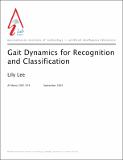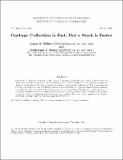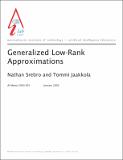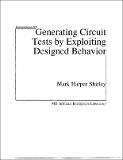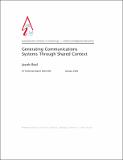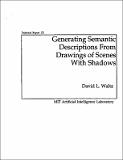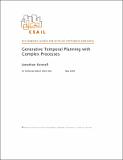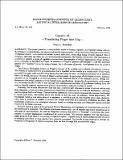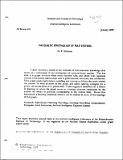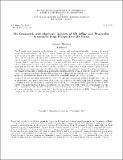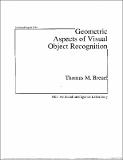Browsing Artificial Intelligence Lab Publications by Title
Now showing items 604-623 of 1835
-
Gait Analysis for Classification
(2003-06-26)This thesis describes a representation of gait appearance for the purpose of person identification and classification. This gait representation is based on simple localized image features such as moments extracted from ... -
Gait Dynamics for Recognition and Classification
(2001-09-01)This paper describes a representation of the dynamics of human walking action for the purpose of person identification and classification by gait appearance. Our gait representation is based on simple features such as ... -
Garbage Collection in a Very Large Address Space
(MIT Artificial Intelligence Laboratory, 1975-09)The address space is broken into areas that can be garbage collected separately. An area is analogous to a file on current systems. Each process has a local computation area for its stack and temporary storage that is ... -
Garbage Collection is Fast, But a Stack is Faster
(1994-03-01)Prompted by claims that garbage collection can outperform stack allocation when sufficient physical memory is available, we present a careful analysis and set of cross-architecture measurements comparing these two approaches ... -
General Purpose Parallel Computation on a DNA Substrate
(1996-12-01)In this paper I describe and extend a new DNA computing paradigm introduced in Blumberg for building massively parallel machines in the DNA-computing models described by Adelman, Cai et. al., and Liu et. al. Employing ... -
Generalization over contrast and mirror reversal, but not figure-ground reversal, in an "edge-based
(2001-12-10)Baylis & Driver (Nature Neuroscience, 2001) have recently presented data on the response of neurons in macaque inferotemporal cortex (IT) to various stimulus transformations. They report that neurons can generalize over ... -
Generalized Low-Rank Approximations
(2003-01-15)We study the frequent problem of approximating a target matrix with a matrix of lower rank. We provide a simple and efficient (EM) algorithm for solving {\\em weighted} low rank approximation problems, which, unlike simple ... -
A Generalized Ordering Constraint for Stereo Correspondence
(1984-05-01)The ordering constraint along epipolar lines is a powerful constraint that has been exploited by some recent stereomatching algorithms. We formulate a generalized ordering constraint, not restricted to epipolar lines. ... -
Generalizing on Multiple Grounds: Performance Learning in Model-Based Technology
(1989-02-01)This thesis explores ways to augment a model-based diagnostic program with a learning component, so that it speeds up as it solves problems. Several learning components are proposed, each exploiting a different kind ... -
Generating and Generalizing Models of Visual Objects
(1985-07-01)We report on initial experiments with an implemented learning system whose inputs are images of two-dimensional shapes. The system first builds semantic network descriptions of shapes based on Brady's smoothed local ... -
Generating Circuit Tests by Exploiting Designed Behavior
(1988-12-01)This thesis describes two programs for generating tests for digital circuits that exploit several kinds of expert knowledge not used by previous approaches. First, many test generation problems can be solved efficiently ... -
Generating Communications Systems Through Shared Context
(2002-01-01)In a distributed model of intelligence, peer components need to communicate with one another. I present a system which enables two agents connected by a thick twisted bundle of wires to bootstrap a simple communication ... -
Generating Compliant Motion of Objects with an Articulated Hand
(1985-06-01)The flexibility of the robot is the key to its success as a viable aid to production. Flexibility of a robot can be explained in two directions. The first is to increase the physical generality of the robot such that ... -
Generating Semantic Description from Drawings of Scenes with Shadows
(MIT Artificial Intelligence Laboratory, 1972-11)The research reported here concerns the principles used to automatically generate three-dimensional representations from line drawings of scenes. The computer programs involved look at scenes which consist of polyhedra and ... -
Generating Semantic Descriptions From Drawings of Scenes With Shadows
(1972-11-01)The research reported here concerns the principles used to automatically generate three-dimensional representations from line drawings of scenes. The computer programs involved look at scenes which consist of polyhedra ... -
Generative Temporal Planning with Complex Processes
(2004-05-18)Autonomous vehicles are increasingly being used in mission-critical applications, and robust methods are needed for controlling these inherently unreliable and complex systems. This thesis advocates the use of model-based ... -
Genetic AI: Translating Piaget into Lisp
(1986-02-01)This paper presents a constuctivist model of human cognitive development during infancy. According to constructivism, the elements of mental representation -- even such basic elements as the concept of physical object ... -
The Genetic Epistemology of Rule Systems
(1978-01-01)I shall describe a model of the evolution of the rule-structured knowledge that serves as a cornerstone of our development of computer-based coaches. The key idea is a graph structure whose nodes represent rules, and ... -
Geometric and Algebraic Aspects of 3D Affine and Projective Structures from Perspective 2D Views
(1993-07-01)We investigate the differences --- conceptually and algorithmically --- between affine and projective frameworks for the tasks of visual recognition and reconstruction from perspective views. It is shown that an affine ... -
Geometric Aspects of Visual Object Recognition
(1992-05-01)This thesis presents there important results in visual object recognition based on shape. (1) A new algorithm (RAST; Recognition by Adaptive Sudivisions of Tranformation space) is presented that has lower average-case ...


